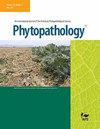Ravinder K Goyal, Joseph P M Hui, Jeffrey Ranches, Roumiana Stefanova, Alysson Jones, Arjun H Banskota, Ian Burton, Bianyun Yu, Fabrice Berrue, Albert Hannig, Shawn Clark, Syama Chatterton, Sangeeta Dhaubhadel, Junzeng Zhang
求助PDF
{"title":"非靶向代谢组分析揭示了皂素在豌豆(Pisum sativum)对根腐病病原体 Aphanomyces euteiches 的部分抗性中的潜在作用。","authors":"Ravinder K Goyal, Joseph P M Hui, Jeffrey Ranches, Roumiana Stefanova, Alysson Jones, Arjun H Banskota, Ian Burton, Bianyun Yu, Fabrice Berrue, Albert Hannig, Shawn Clark, Syama Chatterton, Sangeeta Dhaubhadel, Junzeng Zhang","doi":"10.1094/PHYTO-04-24-0151-R","DOIUrl":null,"url":null,"abstract":"<p><p>In soilborne diseases, the plant-pathogen interaction begins as soon as the seed germinates and develops into a seedling. <i>Aphanomyces euteiches</i>, an oomycete, stays dormant in soil and is activated by sensing the host through chemical signals present in the root exudates. The composition of plant exudates may, thus, play an important role during the early phase of infection. To better understand the role of root exudates in plant resistance, we investigated the interaction between partially resistant lines (PI660736 and PI557500) and susceptible pea cultivars (CDC Meadow and AAC Chrome) against <i>A. euteiches</i> during the pre-invasion phase. The root exudates of the two sets of cultivars clearly differed from each other in inducing oospore germination. PI557500 root exudate not only had diminished induction but also inhibited the oospore germination. The contrast between the root exudates of resistant and susceptible cultivars was reflected in their metabolic profiles. Data from fractionation and oospore germination inhibitory experiments identified a group of saponins that accumulated differentially in susceptible and resistant cultivars. We detected 56 saponins and quantified 44 of them in pea root and 30 from root exudate; the majority of them, especially soyasaponin I and dehydrosoyasaponin I with potent in vitro inhibitory activities, were present in significantly higher amounts in both roots and root exudates of PI660736 and PI557500 compared with Meadow and Chrome. Our results provide evidence for saponins as deterrents against <i>A. euteiches</i>, which might have contributed to the resistance against root rot in the studied pea cultivars. [Formula: see text] Copyright © 2024 His Majesty the King in Right of Canada, as represented by the Minister of Agriculture and Agri-Food Canada and the National Research Council of Canada. This is an open access article distributed under the CC BY 4.0 International license.</p>","PeriodicalId":20410,"journal":{"name":"Phytopathology","volume":" ","pages":"2502-2514"},"PeriodicalIF":2.6000,"publicationDate":"2024-12-01","publicationTypes":"Journal Article","fieldsOfStudy":null,"isOpenAccess":false,"openAccessPdf":"","citationCount":"0","resultStr":"{\"title\":\"Untargeted Metabolomic Analysis Reveals a Potential Role of Saponins in the Partial Resistance of Pea (<i>Pisum sativum</i>) Against a Root Rot Pathogen, <i>Aphanomyces euteiches</i>.\",\"authors\":\"Ravinder K Goyal, Joseph P M Hui, Jeffrey Ranches, Roumiana Stefanova, Alysson Jones, Arjun H Banskota, Ian Burton, Bianyun Yu, Fabrice Berrue, Albert Hannig, Shawn Clark, Syama Chatterton, Sangeeta Dhaubhadel, Junzeng Zhang\",\"doi\":\"10.1094/PHYTO-04-24-0151-R\",\"DOIUrl\":null,\"url\":null,\"abstract\":\"<p><p>In soilborne diseases, the plant-pathogen interaction begins as soon as the seed germinates and develops into a seedling. <i>Aphanomyces euteiches</i>, an oomycete, stays dormant in soil and is activated by sensing the host through chemical signals present in the root exudates. The composition of plant exudates may, thus, play an important role during the early phase of infection. To better understand the role of root exudates in plant resistance, we investigated the interaction between partially resistant lines (PI660736 and PI557500) and susceptible pea cultivars (CDC Meadow and AAC Chrome) against <i>A. euteiches</i> during the pre-invasion phase. The root exudates of the two sets of cultivars clearly differed from each other in inducing oospore germination. PI557500 root exudate not only had diminished induction but also inhibited the oospore germination. The contrast between the root exudates of resistant and susceptible cultivars was reflected in their metabolic profiles. Data from fractionation and oospore germination inhibitory experiments identified a group of saponins that accumulated differentially in susceptible and resistant cultivars. We detected 56 saponins and quantified 44 of them in pea root and 30 from root exudate; the majority of them, especially soyasaponin I and dehydrosoyasaponin I with potent in vitro inhibitory activities, were present in significantly higher amounts in both roots and root exudates of PI660736 and PI557500 compared with Meadow and Chrome. Our results provide evidence for saponins as deterrents against <i>A. euteiches</i>, which might have contributed to the resistance against root rot in the studied pea cultivars. [Formula: see text] Copyright © 2024 His Majesty the King in Right of Canada, as represented by the Minister of Agriculture and Agri-Food Canada and the National Research Council of Canada. This is an open access article distributed under the CC BY 4.0 International license.</p>\",\"PeriodicalId\":20410,\"journal\":{\"name\":\"Phytopathology\",\"volume\":\" \",\"pages\":\"2502-2514\"},\"PeriodicalIF\":2.6000,\"publicationDate\":\"2024-12-01\",\"publicationTypes\":\"Journal Article\",\"fieldsOfStudy\":null,\"isOpenAccess\":false,\"openAccessPdf\":\"\",\"citationCount\":\"0\",\"resultStr\":null,\"platform\":\"Semanticscholar\",\"paperid\":null,\"PeriodicalName\":\"Phytopathology\",\"FirstCategoryId\":\"97\",\"ListUrlMain\":\"https://doi.org/10.1094/PHYTO-04-24-0151-R\",\"RegionNum\":2,\"RegionCategory\":\"农林科学\",\"ArticlePicture\":[],\"TitleCN\":null,\"AbstractTextCN\":null,\"PMCID\":null,\"EPubDate\":\"2024/12/6 0:00:00\",\"PubModel\":\"Epub\",\"JCR\":\"Q2\",\"JCRName\":\"PLANT SCIENCES\",\"Score\":null,\"Total\":0}","platform":"Semanticscholar","paperid":null,"PeriodicalName":"Phytopathology","FirstCategoryId":"97","ListUrlMain":"https://doi.org/10.1094/PHYTO-04-24-0151-R","RegionNum":2,"RegionCategory":"农林科学","ArticlePicture":[],"TitleCN":null,"AbstractTextCN":null,"PMCID":null,"EPubDate":"2024/12/6 0:00:00","PubModel":"Epub","JCR":"Q2","JCRName":"PLANT SCIENCES","Score":null,"Total":0}
引用次数: 0
引用
批量引用

 求助内容:
求助内容: 应助结果提醒方式:
应助结果提醒方式:


